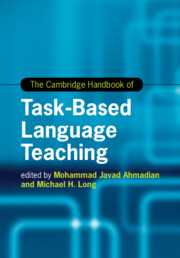Book contents
- The Cambridge Handbook of Task-Based Language Teaching
- Cambridge Handbooks In Language And Linguistics
- The Cambridge Handbook of Task-Based Language Teaching
- Copyright page
- Dedication
- Contents
- Figures
- Tables
- Contributors
- Preface The Origins and Growth of Task-Based Language Teaching
- Part I The Rationale for Task-Based Language Teaching
- Part II Tasks and Needs Analysis
- Part III The Task Syllabus and Materials
- Part IV Methodology and Pedagogy
- Part V Task-Based Language Teaching with School-Age Children
- Part VI The Teacher in Task-Based Language Teaching
- Part VII Task-Based Assessment and Program Evaluation
- 13 Task-Based Language Assessment
- 14 Evaluating Task-Based Language Programs
- 14A Comparing the Effectiveness of Task-Based Language Teaching and Presentation-Practice-Production on Second Language Grammar Learning
- 14B Examining High-School Learners’ Experience of Task Motivation and Difficulty in a Two-Week Spanish Immersion Camp
- 14C Designing a Classroom-Based Task-Based Language Assessment Framework for Primary Schools
- Part VIII Research Needs and Future Prospects
- Index
- References
13 - Task-Based Language Assessment
from Part VII - Task-Based Assessment and Program Evaluation
Published online by Cambridge University Press: 19 November 2021
- The Cambridge Handbook of Task-Based Language Teaching
- Cambridge Handbooks In Language And Linguistics
- The Cambridge Handbook of Task-Based Language Teaching
- Copyright page
- Dedication
- Contents
- Figures
- Tables
- Contributors
- Preface The Origins and Growth of Task-Based Language Teaching
- Part I The Rationale for Task-Based Language Teaching
- Part II Tasks and Needs Analysis
- Part III The Task Syllabus and Materials
- Part IV Methodology and Pedagogy
- Part V Task-Based Language Teaching with School-Age Children
- Part VI The Teacher in Task-Based Language Teaching
- Part VII Task-Based Assessment and Program Evaluation
- 13 Task-Based Language Assessment
- 14 Evaluating Task-Based Language Programs
- 14A Comparing the Effectiveness of Task-Based Language Teaching and Presentation-Practice-Production on Second Language Grammar Learning
- 14B Examining High-School Learners’ Experience of Task Motivation and Difficulty in a Two-Week Spanish Immersion Camp
- 14C Designing a Classroom-Based Task-Based Language Assessment Framework for Primary Schools
- Part VIII Research Needs and Future Prospects
- Index
- References
Summary
This case study discusses an online second language teacher education course, designed for teachers, teacher educators, directors of studies and course designers, created and run by the authors, who are both members of a language services cooperative in Barcelona. Information about the cooperative is given, and the events leading to the start of the project are described. Having outlined Long’s (2015) approach to task-based language teaching (TBLT), which serves as the model for the course, we describe the course itself, and the components of its twelve sessions. We go on to explain how we wrote the course and how, once complete, it was marketed. The first implementation of the course is then described, including details of the participants’ working roles; their highest qualifications; their engagement with course activities; the completion rates; and feedback. We then explain how the second implementation reflected changes we made to the course as a result of our reflections and feedback. Finally, we discuss the strengths and weaknesses of the course, paying particular attention to loop input (Woodward, 2003) and to the principle of faithfully reflecting TBLT processes so that the course practices what it preaches.
Keywords
- Type
- Chapter
- Information
- The Cambridge Handbook of Task-Based Language Teaching , pp. 507 - 528Publisher: Cambridge University PressPrint publication year: 2021
References
Further Reading
References
- 6
- Cited by

